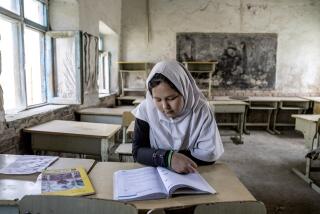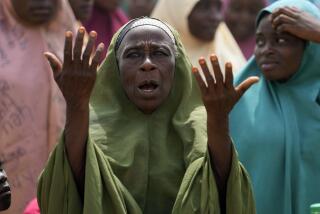Taliban’s attack on Pakistan education goes beyond one girl
SWABI, Pakistan — Under a torrid sun on a parched patch of dirt, 65 young boys and girls wiped sweat from their foreheads and struggled to concentrate on their studies. There were no blackboards, no desks.
Nearby, their white two-room country school sat abandoned, shrapnel holes gouged into the exterior. The roof and walls had cracked, making the building too dangerous to use — the result of a homemade bomb detonated by the Taliban on the school’s porch.
“Everything was fine here,” said 9-year-old Fazl Qadeem, squatting on the ground with his lesson book in hand. “And they destroyed it.”
The Taliban outraged millions of Pakistanis and people around the world this month when its gunmen attempted to kill Malala Yousafzai, a 15-year-old girl who publicly championed the education of girls. But that attack was just one small piece of a long campaign against the country’s education system.
PHOTOS: Pakistani teen shot by Taliban
School buildings like the one in Swabi are blown up with astonishing regularity: 96 were damaged or destroyed by militants this year, according to Human Rights Watch, a rate of more than two per week. Last year, 152 schools were hit. Militants have targeted school buses, teachers, headmasters, even a provincial education minister.
The damage is palpable and far-reaching, especially in northwestern Pakistan, where the Taliban maintains its nerve centers.
For parents like Sher Zameer, whose son survived a Taliban ambush of a school bus a year ago that killed the driver and four boys, the joy of watching his son go to class has turned to dread. “We don’t want our kids to get killed for the sake of education,” he said. “After this attack, the enthusiasm is gone.”
At least 600,000 children in northwestern Pakistan have missed a year or more of school because of militant attacks or threats, according to the Society for the Protection of the Rights of the Child, an Islamabad-based nongovernmental group. In neighborhoods hit by school bombings, parents are pulling their children out of classrooms. More than half the schools destroyed in the northwest have yet to be rebuilt. Teachers in conflict zones have sought transfers to safer areas, leading to a shortage of instructors.
Pakistan desperately needs to shore up its weak, cash-starved education system if it hopes to build a path out of poverty for vast numbers of its citizens. Half the country’s nearly 180 million people are under 17, and the population is expected to soar to 335 million by 2050.
Large numbers of uneducated or poorly educated Pakistanis provide ideal fodder for the country’s myriad militant groups, as well as a rapt audience for hard-line religious clerics who preach intolerance and extremism.
“When the quality of education suffers, you always have a generation of children growing up frustrated and angry,” said Zarina Jillani, executive director of the children’s rights society. “A generation of children is being created without any real hope for the future. You can imagine the ramifications of that.”
The Pakistani Taliban is an amalgam of militant factions bent on toppling the government and imposing Islamic law. It regards government education as secular and therefore un-Islamic.
“Their view of education is that it should be largely limited to the Koran, as it’s understood by them,” said Ali Dayan Hasan, Pakistan director for Human Rights Watch.
The shooting of Malala illustrated the Taliban’s opposition to girls’ education. She was only 11 when she wrote in a BBC blog about the Taliban decree against girls attending school in the Swat Valley, her home. Taliban gunmen boarded her school bus and shot her in the head Oct. 9. She survived and is recovering in a British hospital.
The Taliban’s deep animosity for girls’ education reflects the group’s desire to thwart any kind of empowerment of women, said Jillani. “It’s part of an overall oppression of women,” she said. “The right for a woman to marry who she wants, her right to inheritance — it’s all part of it.”
But the bombings, which almost always occur at night when children are not present, target boys’ as well as girls’ schools.
“They want to throw us back into the Stone Age,” said Sardar Hussain Babak, education minister for Khyber-Pakhtunkhwa province, home to the Swat Valley and Pakistan’s tribal areas. “If there is no education, extremism and religious fanaticism will rule. This is clear. So they don’t want people to be educated; they don’t want them to be informed.”
Schools in rural areas are especially easy targets for the militants. Khyber-Pakhtunkhwa province has thousands of schools, and no way to deploy armed guards at each one.
In Swabi, teachers kept classes going for dozens of children between the ages of 5 and 10, but had to move them outside.
“God knows why they do it,” instructor Mohammed Tayyib said of the Taliban. “As a teacher, it’s very frustrating. We’re trying our best, but it has definitely affected my level of motivation. And it has done the same to the students.”
When police do make arrests, said Babak, the provincial education minister, judges often release the suspects weeks later, citing shoddy investigative work. He can attest to that firsthand.
Last year, militants attacked his convoy in the middle of the night, spraying his car with bullets, one of which fractured a bone in his right hand. Several suspects were captured, but a court released them three months later.
The Taliban also claimed responsibility for attacking a bus carrying Sher Zameer’s son and other students home from Khyber Model School outside Peshawar in September 2011, calling it retaliation for a decision by tribal leaders from the suburb of Mattani to form anti-Taliban militias. The militias had set up checkpoints around villages served by the school, said Asghar Khan, whose only son, Mohammed Naveed Khan, was one of those killed.
A dozen black-clad militants crouched in wait behind a roadside berm and opened fire when the bus drove by, so crowded that children were clinging to the roof and sides. The attackers killed the driver first, then shot out the tires. They pumped hundreds of AK-47 rounds and fired rockets at screaming boys and girls who leaped onto the road and sprinted for cover.
No one has been charged. It took survivors months to overcome their fear. Zameer’s son, 15-year-old Arshad Alam, was out of class for 10 weeks. “Every time I thought of restarting school, images from the attack would replay in my mind and keep me from going back,” he said.
Mohammed Zarshad, injured by shrapnel that pierced his hands and sheared off part of his right ear, didn’t go back for seven months.
PHOTOS: Pakistani teen shot by Taliban
“It’s not acceptable in any society for people to attack schoolchildren or schools,” said Khan. “One of the dead was a 5-year-old child. What did that boy do to deserve being killed?”
More to Read
Start your day right
Sign up for Essential California for news, features and recommendations from the L.A. Times and beyond in your inbox six days a week.
You may occasionally receive promotional content from the Los Angeles Times.






